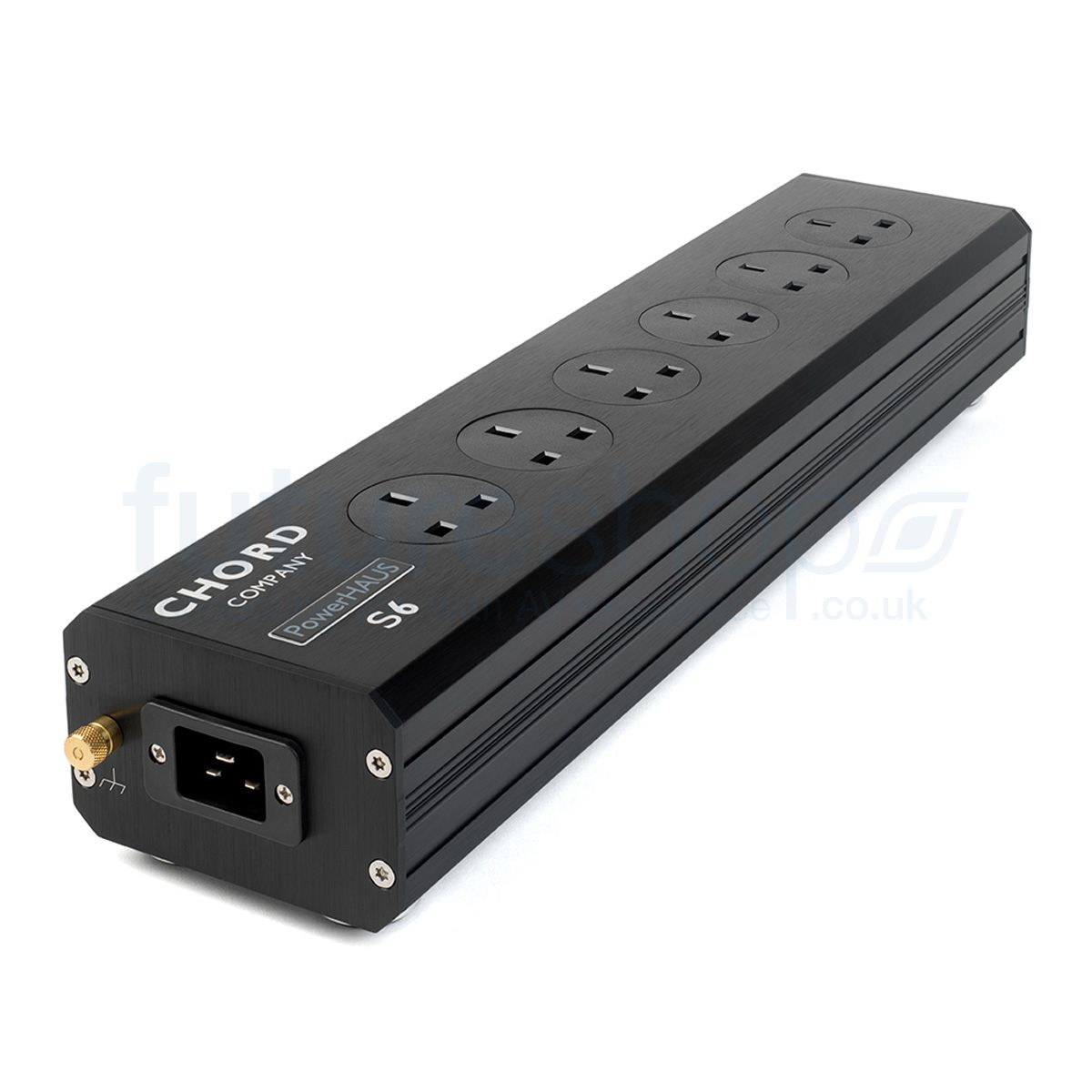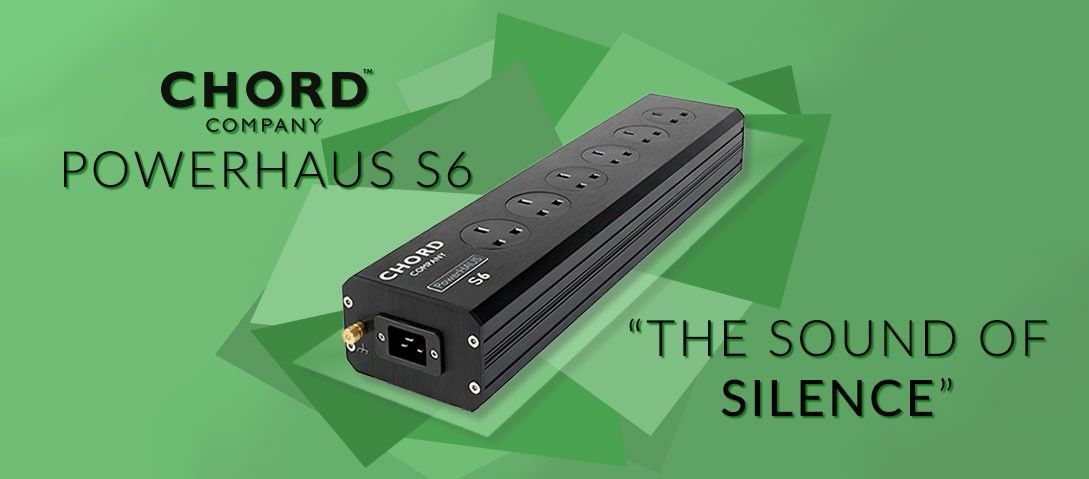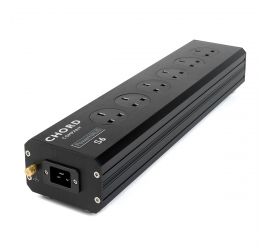Introduction to Chord PowerHAUS S6 Mains Distribution Block
A healthy diet of power can be fed to your hi-fi in various ways: mains conditioners, AC regenerators and ordinary distribution blocks, each offering their own benefits (we'll explore that another time). The Chord Company puts its extensive experiences into the latter, but their power blocks are far from ordinary.
China built the Mini Sky City – 57 floors – in 19 days. Chord spent more than 19 years assembling their house . . . sorry . . . HAUS in Amesbury, UK (yes, some of the parts are from the East).
The PowerHAUS S6 and its big brother, the M6, are much more than 6-way power blocks; it's all in the architecture. There is no series filtering, no switches or lights, no bells and definitely no whistles. In fact, nothing in it could potentially introduce electronic noise into your power chain, resulting in incredibly clean, dynamic performance from your hi-fi system.
Brick HAUS: Built to Last and Perform
Free from any series filter features, the S6 features parallel ARAY technology and the M6 three parallel connected MainsARAYs as well as the ARAY tech found in the S6, in case you're asking: "What in the world am I paying for here?". If breathtaking dynamics and expansive soundstage are not convincing enough answers, consider its superb build quality; it's built like a brick . . . you know what. A solid, well-machined aluminium casing houses a special arrangement of heavy-gauge, well-shielded cables running to carefully chosen, high-quality sockets; all handpicked for sound quality. The rigid aluminium construction not only gives the distribution block electrical isolation but also reduces the effect of microphony – where mechanical vibrations in components turn into electrical noise.

The Technology Inside: Chord's Wiring Excellence
The internal wiring (and Chord Company have been doing fancy things with wires in the UK since 1984) is to the standard expected from a company whose business is building cables. Cable shielding and quality conductors play a huge role in Chord's clarity, and that's what has been applied to the PowerHAUS. But, moreover, it's the way Chord arranges the wiring.
Instead of conventionally used star-wiring (all outlets wired to the common inlet), three parallel bus bars (heavy-duty solid rail conductors) isolate the earth bar from the live and neutral bars. This, Chord says, reduces susceptibility to electronic noise. It makes sense.
ARAY Technology: The Heart of PowerHAUS
HAUS stands for Hybrid ARAY Unfiltered Supply, so you can guess their exclusive ARAY technology – what Chord applies to all but their speaker cables (apart from their flagship ChordMusic speaker cables) is found within the S6 and M6 at different levels. The S6 applies 'TunedARAY' before power leaves the unit, while the M6 adds three of their 'MainsARAY' noise absorbers after power enters it.
Without sending you to sleep, ARAY means Audio Reflection, Attenuating Yoke. It uses clever maths to balance the loss and retention of what travels along a cable. ARAY is a passive technology that attenuates signal reflections caused by cable imperfections and gives HF noise somewhere to go. This explains the PowerHAUS S6's remarkably low noise floor.
Open HAUS: Real-World Sound Testing
For such a spartan piece of kit, we spent a lot of time on it – one song, another song, with it, without it, comparing other units. We liked it.
The first track – classic hi-fi testing material – Tracy Chapman's Mountain O' Things showed how the PowerHAUS coped with well-balanced music. The song sounded natural, distinguishing the intro's delicate marimba tones from the subtle palm-muted guitar rhythm. Chapman's contralto voice (the lowest female vocal range) had its timbre precisely defined amid the characteristic musical texture of the 80s, while the low noise floor gave the music space to move and the bass able to punch more assertively.
For a contemporary spin, Lou Hayter's punchy track, Time Out of Mind, came at us with a lively snap from the music's leading edges while the impression of movement kept the song bouncing into the crunchy guitar solo.
Finally, Ben E King's Supernatural Thing lets our PowerHAUS S6 show us its rhythmic talent. When that track ended, it just had to be played again. We were reminded that lowering the noise floor like this exposes the transients in sounds, giving leading edges that exciting cadence, which involves us with music.
The HAUS Always Wins: Chord's Power Distribution Philosophy
A quote from an audio engineer friend explains what we think Chord are trying to achieve:
"It's not all about the high-frequency detail that makes good sound; it's what you don't hear that reveals the quality of sound – the sound of silence."
Chord Company's approach to power distribution – without serial conditioning and filtering – allows your amplifier to breathe, preserving the dynamics but keeping noise away from it. Filtered blocks are often reserved for source and other low-draw components with powerful amps still plugged into the wall. With the PowerHAUS solutions, all six components, including power amplifiers, can benefit from it.
Elevating Sound Quality: The PowerHAUS Experience with AudioQuest Monsoon Cable
One last thing: although to meet safety standards, the S6 and the M6 are supplied with a basic 16 Amp C19 power cable, we couldn't resist another listen with a more capable one. We used the AudioQuest Monsoon – a firm favourite. The enhanced clarity was complimented by a beautifully shiny and smooth top-end with even more dynamics. We think a unit like the Chord PowerHAUS S6 and M6 to be a welcome addition to any mid to high-end system and worth considering power cable upgrades. One of our expert technical advisers will be happy to help you with your decision.


